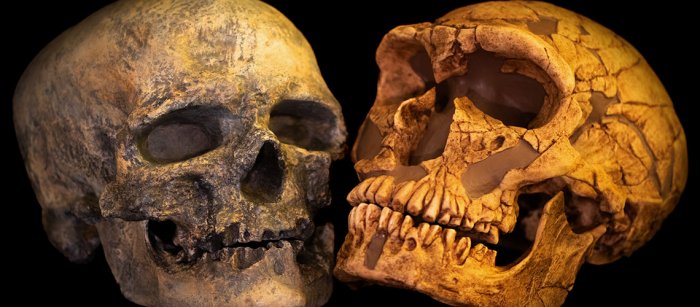Conny Waters – AncientPages.com – By analyzing genomes up to 40,000 years old, scientists have traced the history of migrations between Homo Sapiens and Neanderthals.
About 40,000 years ago, Neanderthals, who had lived for hundreds of thousands of years in the western part of the Eurasian continent, gave way to Homo sapiens, who had arrived from Africa. This replacement was not sudden, and the two species coexisted for a few millennia, resulting in the integration of Neanderthal DNA into the genome of Sapiens.

Credit: Adobe Stock – 2ragon
Researchers at the University of Geneva (UNIGE) have analyzed the distribution of the portion of DNA inherited from Neanderthals in the genomes of humans (Homo sapiens) over the last 40,000 years. These statistical analyses revealed subtle variations in time and geographical space. This work, published in the journal Science Advances, helps us to understand the common history of these two species.
Thanks to genome sequencing and comparative analysis, it is established that Neanderthals and Sapiens interbred and that these encounters were sometimes fruitful, leading to the presence of about 2% of DNA of Neanderthal origin in present-day Eurasians. However, this percentage varies slightly between regions of Eurasia, since DNA from Neanderthals is somewhat more abundant in the genomes of Asian populations than in those of European populations.
One hypothesis to explain this difference is that natural selection would not have had the same effect on genes of Neanderthal origin in Asian and European populations. Mathias Currat’s team, senior lecturer in the Department of Genetics and Evolution at the UNIGE Faculty of Science, is working on another hypothesis.
His previous work, based on computer simulations, suggests that such differences could be explained by migratory flows: when a migrant population hybridizes with a local population, in their area of cohabitation, the proportion of DNA of the local population tends to increase with distance from the point of departure of the migrant population.
Europe: a territory shared by both species
In the case of Sapiens and Neanderthals, the hypothesis is that the further one moves away from Africa, Homo sapiens’ point of origin, the greater the proportion of DNA from Neanderthal, a population mainly located in Europe. To test this hypothesis, the authors used a database made available by Harvard Medical School that includes more than 4,000 genomes from individuals who have lived in Eurasia over the past 40 millennia.
‘‘Our study is mainly focused on European populations since we are obviously dependent on the discovery of bones and the state of conservation of DNA. It turns out that archaeological excavations have been much more numerous in Europe, which greatly facilitates the study of the genomes of European populations,’’ explains Claudio Quilodrán, senior research and teaching ᴀssistant in the Department of Genetics and Evolution at the UNIGE Faculty of Science, and co-first author of the study.
Statistical analyses revealed that, in the period following the dispersal of Homo sapiens from Africa, the genomes of Paleolithic hunter-gatherers who lived in Europe contained a slightly higher proportion of DNA of Neanderthal origin than the genomes of those who lived in Asia. This result is contrary to the current situation but in agreement with paleontological data, since the presence of Neanderthals was mainly reported in western Eurasia (no Neanderthal bones have been discovered further east than the Altai region of Siberia).
The arrival of Anatolian farmers modifies genomes
Subsequently, during the transition to the Neolithic, i.e. the transition from the hunter-gatherer lifestyle to the farmer lifestyle, 10,000 to 5,000 years ago, the study shows a decline in the proportion of DNA of Neanderthal origin in the genomes of European populations, resulting in a slightly lower percentage than that of Asian populations (as currently observed).
This decrease coincided with the arrival in Europe of the first farmers from Anatolia (Turkey’s western peninsula) and the Aegean area, who themselves carried a lower proportion of DNA of Neanderthal origin than the inhabitants of Europe at the same time. By mixing with the populations of Europe, the genomes of farmers from Anatolia ‘‘diluted’’ Neanderthal DNA a little more.

The UNIGE team analysed the distribution of the portion of DNA inherited from Neanderthals in the genomes of humans (Homo sapiens) over the last 40,000 years. © Claudio Quilodrán
This study shows that the analysis of ancient genomes, coupled with archaeological data, makes it possible to trace different stages in the history of hybridized species.
‘‘In addition, we are beginning to have enough data to describe more and more precisely the percentage of DNA of Neanderthal origin in the genome of Sapiens at certain periods of prehistory. Our work can therefore serve as a reference for future studies to more easily detect genetic profiles that deviate from the average and might therefore disclose an advantageous or disadvantageous effect,’’ concludes Mathias Currat, last author of the study.
Via Eurekalert
The study was published in the journal Science Advances
Written by Conny Waters – AncientPages.com Staff Writer





